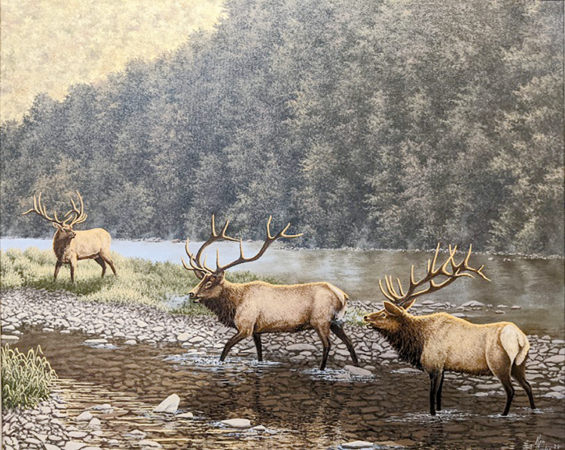Elk were native to Pennsylvania when the first European settlers arrived in our area, but the elk were no doubt a major and much-needed food source at that time. There were obviously no hunting regulations, and by the 1870s, Pennsylvania’s native elk were believed to be gone. The creation of the Game Commission, however, in 1895 set the stage for the return of the elk to Pennsylvania. Pennsylvania’s first shipment of 50 Yellowstone elk purchased at $30 each arrived in 1913, and 22 more were purchased from a preserve in Monroe County. In 1923, we saw the return of elk hunting to Pennsylvania; only bulls with at least four points on one antler could be taken, and no drives were permitted. In that first hunt, 26 elk were taken, and 25 over the next three years, but by 1931, only one was taken, and that ended elk hunting in Pennsylvania.
Over the years, a herd of hardly 60 elk lingered in parts of northern Pennsylvania. In the 60s, growing up in the DuBois area, I remember seeing an occasional elk in the Penfield area, but it was a rare and much talked about sighting. In the years that followed, the Game Commission ramped up its research and habitat work and, in 1998, instituted a trap-and-transfer project that expanded the elk range from 350 to 800 square miles. From 1913-1926, a total of 177 Rocky Mountain elk were acquired, and our elk herd is now over 1,000 with a range of 10 counties and over 1000 square miles. Elk County is credited with having the largest free-roaming elk herd in the northeastern United States.
By 2001, elk hunts were back on the table, and more than 50,000 people applied for one of the 30 licenses being offered, and 27 elk were taken that year. Since then, the number of applicants has grown, and so has the hunting success. In Aug. of 2022, there were 104,250 applications for 178 elk tags. In recent years, the Game Commission has added archery season and late seasons to the elk hunt, and year after year, hunters are taking more and bigger bulls than ever before. In 2009, I was one of those lucky recipients, and on the second day of my unguided hunt, I bagged an 8×8 bull that was the fourth largest in the state that year. Since then, however, a good number of larger bulls have been taken, some sporting more than 400 inches of antler, enough to rank them among the largest in the world.
Not only is elk hunting interest increasing here in our state, but so is the elk watching and tourism. It is estimated that elk watching, and nature tourism have generated an estimated $250 million in spending annually over the five-county elk range here in Pennsylvania. If you haven’t been out on an elk watch, you should plan to head to the Winslow Hill area for the best results. A good time is in the fall before the rut is underway; you will very likely see bulls butting antlers, and photo opportunities are often available. Another good viewing area is around Kettle Creek and Cross Fork. I stay at a cabin along Kettle Creek every year, and seeing elk cross the creek inspired me to produce the painting “Kettle Creek Crossing,” which accompanies this article.




